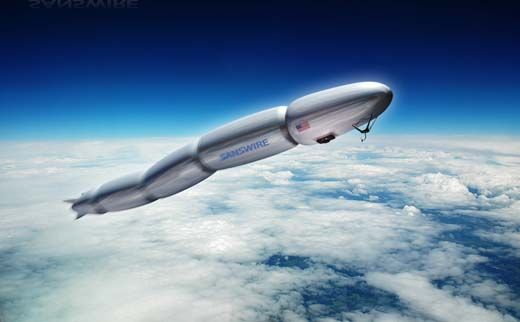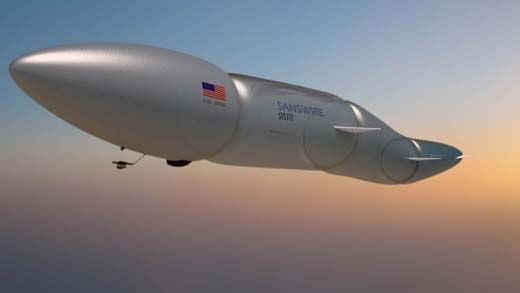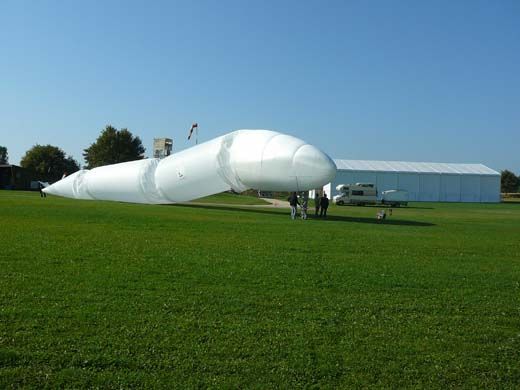Sky Snake
Flexible blimps are bending the rules on UAV design.
/https://tf-cmsv2-smithsonianmag-media.s3.amazonaws.com/filer/STS_111-from%20sanwire.jpg)
The blimp—that bloated, egg-shaped thing that blocks out the sun at major public events—remains one of aviation’s oddballs. Think Stay Puft Marshmallow Man in the movie Ghostbusters. And it’s a high-maintenance oddball: lots of construction and operating costs relative to the few people it carries. No speed. Huge amounts of hangar space needed to shelter it when nasty weather arrives. How does this thing get work? Other than hoisting cameras above the Super Bowl for 10-second shots during TV commercial breaks, the blimp, or zeppelin as it’s never called anymore, has been a caricature of itself for decades.
Leave it to the Germans to think, we can do a better blimp. TAO (Trans-Atmospheric Operations) Technologies GmbH, of Stuttgart, Germany, partnered a few years ago with the University of Stuttgart, and more recently with Ft. Lauderdale, Florida-based Sanswire Corporation (from the French “sans” for “without” paired with the English “wires”) to develop and market a new kind of airship, the Stratellite—a smaller, more flexible, unmanned, autonomous blimp that may rewrite the books on the value of lighter-than-air vehicles.
The biggest plus for blimps is their time in the air, which can last days to weeks depending on whether they have people on board. Their biggest drawback is that when the wind blows hard from the side, they don’t stay on course very well. And several thousand feet up, blimps encounter a lot of wind.
For a blimp driver trying to angle for a good camera shot of a football stadium, it’s not a matter of life and death. For soldiers on the ground in Kandahar trying to maintain, say, a communications link to their supply base, or a video feed of insurgents across the valley, the stakes are higher.
Sanswire-TAO has done away with the rigid blimp design in favor of a flexible one, with segments linked like sausages inside a double-sleeve design. The vehicle looks like that hinged plastic toy snake you played with as a kid. As it undulates in the sky in a cross wind, it bleeds off the energy of the gusts, and stays on course or in place more efficiently.
“We focus strictly on being an eye in the sky—a very low-cost eye in the sky,” says Daniel Erdberg, Sanswire-TAO vice president of operations. “It’s not a complicated machine like a typical aircraft. Our [flight] duration exceeds anything on the market just due to design, to physics.”
Made mainly of rip-stop nylon, the multiple-cell airship, still in the test phase, would come in a crate that can be unpacked by two soldiers and deployed in a matter of hours. The forward bladder is filled with helium, which gives the airship its buoyancy. The rest of the bladders are filled with a gaseous, combustible fuel that gets compressed before being fed into a one-cylinder, reciprocating engine mounted below the front section, which pulls the airship along at almost 40 miles an hour.
The company’s current model, the STS-111, which is 111 feet long and 11 feet in diameter, can stay aloft for up to three days at altitudes between 10,000 feet and 30,000 feet. A larger version on the drawing board will go to 60,000 feet, where it will loiter for up to a month, with an expected top speed around 85 miles an hour. “At that altitude,” says Erdberg, “the airship has a line-of-sight view over an area the size of Texas.”
While research is moving ahead on how to get propeller-driven, airplane-type unmanned aerial vehicles (UAVs) to stay aloft for weeks, months, or even years—mainly with light, durable solar cells that charge batteries by day to keep the propellers turning at night—Sanswire-TAO claims they’re ready to fill a need now for more persistent UAV loitering where it’s needed: mainly in the military, but also for homeland security, border patrol, environmental study, commercial telecommunications, and maritime needs.
“We said, ‘Duration, duration, duration,’ measured in weeks. That’s what our soldiers need now,” says Erdberg. Sanswire-TAO conducted their latest demonstration of their airship on December 17 and 18 in Stuttgart. “We’ve built about 30 prototypes and have flown them thousands of times,” he says.
He claims that the cost of a Predator-class UAV is many times the cost of an airship of this kind. An STS-111 would run about $3 million to purchase, but only about $50 an hour to operate. “You crash a Predator, and that’s a tremendous cost, somewhere between $12 million and $18 million a pop,” says Erdberg. “Predators run around $2,000 an hour [to operate], and sometimes much more.”
The Stratellite, the company’s high-altitude vehicle, would find what Erdberg calls a “sweet spot” around 60,000 feet where it would experience the least amount of average wind. “Below and above that layer it’s very windy,” he says. “The idea,” he continues, “is to mix a balloon with an airship. Without fuel, it just becomes a balloon.”
Erdberg says that solar cell technology isn’t as far along as it needs to be. One of many problems for solar cells operating at very high altitudes is overheating from the sun’s powerful radiation. “We do believe that solar technology is the future,” says Erdberg. He claims that the company is doing research in that area. “But our gas technology is ready today.” In the second quarter of 2010, the company plans a public unveiling of their airships for two days at the Orlando Sanford International Airport.
“This is outside the box,” Erdberg says. “You’re taught something in school every day, but then this is something very different.”


